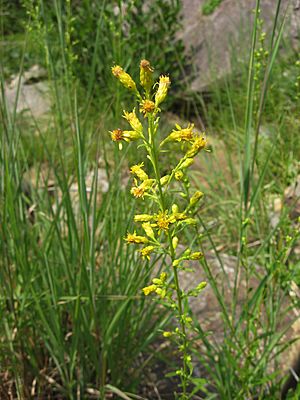Locust Fork goldenrod facts for kids
Quick facts for kids Locust Fork goldenrod |
|
|---|---|
 |
|
| Conservation status | |
| Scientific classification | |
| Genus: |
Solidago
|
| Species: |
arenicola
|
The Locust Fork goldenrod (scientific name: Solidago arenicola) is a special and rare flowering plant. It belongs to the aster family, which also includes sunflowers and daisies. This plant gets its common name from the Locust Fork River in Alabama, where it was first discovered.
What is the Locust Fork Goldenrod?
The Locust Fork goldenrod is a type of plant that comes back year after year. It is known as a perennial herb. This means it's not a tree or a bush, but a plant with soft stems that lives for more than two years.
Where Does it Grow?
This rare plant is found in only two states in the United States: Tennessee and Alabama. It grows in very specific places called "riverside scour areas." These are rocky, often wet, areas along rivers on the Cumberland Plateau. The plant is endemic to these spots, meaning it naturally grows nowhere else in the world. Even though it's rare overall, you might find many of them growing together in these particular river areas.
What Does it Look Like?
The Locust Fork goldenrod can grow quite tall, reaching up to 80 centimeters (about 32 inches). That's almost as tall as a typical 10-year-old! It has a woody rhizome underground, which is like a thick stem that helps the plant store energy and spread.
Its leaves can be up to 15 centimeters (about 8 inches) long. Most of these leaves are found closer to the bottom of the plant's stem. When it blooms, one plant can produce as many as 50 bright yellow flower heads. These flowers grow on the upper branches, making the plant look very colorful.


